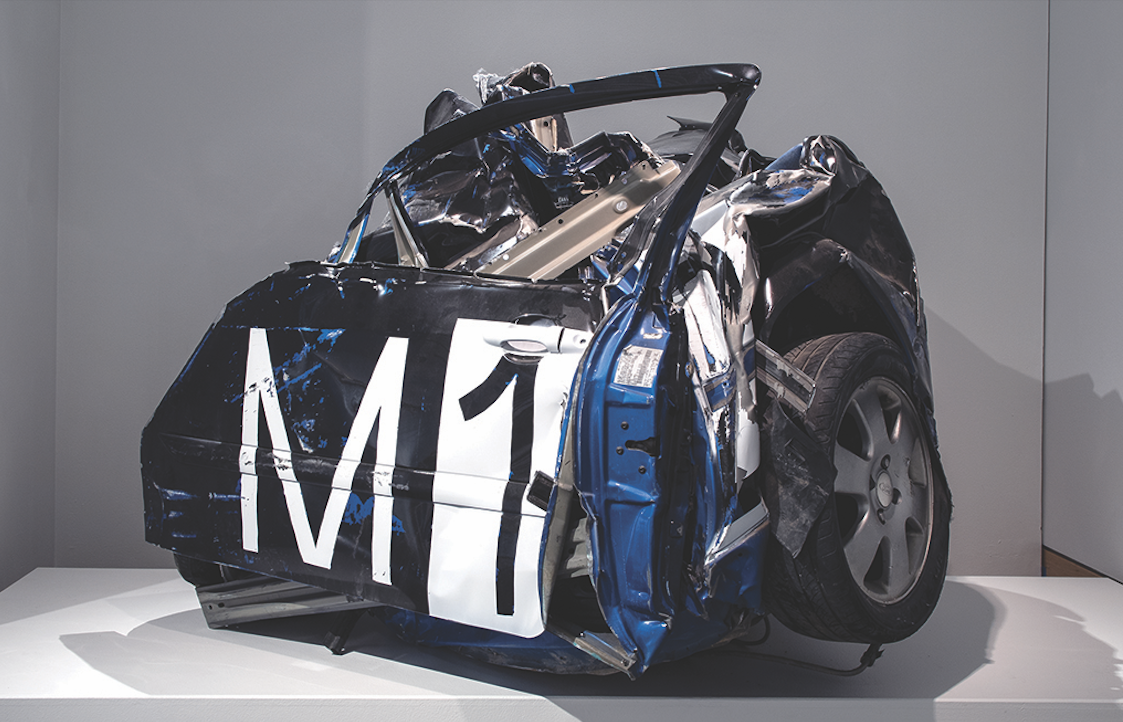M12 Studio:
Black Hornet #5 (Crush), 2020
crushed automobile
courtesy of M12 Studio
resources:
studio site
Black Hornet documentary
“Rural America, M12, and The Center Pivot Library,” Neil Fauerso, Glasstire
“Human-Horse Bond Reflects Rural & Urban Culture,” John Pemble, Iowa Public Radio

“Some families camp, some hunt – we’ve always raced. It’s what we’ve always done. Everything we do, we plan around racing: vacations, weddings, holidays. It’s not just a hobby, it is a way of life,” said Chris Hall. “The biggest thing that struck me about doing [the Black Hornet project] was what all was entailed between the family, the friends, and looking at the car beyond just a ‘car,’ but as a means of gathering people.”
Beginning in 2009, Richard Saxton (visual artist and founder of M12 Studio) along with other artists and researchers within M12 partnered with the Hall family racing team to create and operate The Black Hornet – a series of dirt track race cars that run in the hornet class at the I-76 Speedway in Fort Morgan, Colorado. This durational project manifests M12’s “connective aesthetic” methodology, which moves art objects beyond their general institutional confines and offers them as a catalyst for cultural and generational exchange. This value of honoring local rural traditions has been a hallmark of the studio’s work for over 15 years, and has animated publications, sculptures, and installations in venues as diverse as the Venice Architecture Biennale, the Iowa State Fair, and The Center for Land Use Interpretation.
At regional speedways, the Hornet class provides the most affordable way for new drivers to gain experience, and M12 Studio leveraged its participation in the project to support the emerging third generation of Hall drivers (Cody and Cole) in their inaugural seasons behind the wheel. Thus, while a sculptural object, a performance piece, and a socially engaged action, The Black Hornet stands more directly and honestly as an effort to share the story of one form of community and culture in the High Plains region.
This series takes two paths in the High Visibility exhibition. Most noticeably, with Black Hornet #5 (Crush), M12 Studio worked with the Hall family to learn about the mechanics of the car while preparing the vehicle for salvage. Then, M12 and the Hall family travelled together to a salvage yard in eastern Colorado to sculpt the piece into its final form. “This moment gave us the chance to express something else that is present in the Black Hornet series,” said Richard Saxton. “(Crush) is able to speak a language that is much more sculptural than the community-focused pieces of our previous Black Hornets. It acknowledges the grit, and also the danger, that is also a part of the racing ecosystem.” The relational work of this project will continue at the I-76 Speedway in the spring of 2021, as M12 will sponsor Black Hornet #6 and Austin Hall’s first season at the racetrack.
The work of M12 Studio has been featured across a number of the publications that have begun to consider the terrain of contemporary rural arts and cultural practice, including The Whitechapel Gallery’s The Rural: Documents of Contemporary Art and Lucy Lippard’s Undermining: A Wild Ride Through Land Use, Politics, and Art in the Changing West; alongside many recordings and multidisciplinary publications, M12 Studio released in 2014 a field-scanning book on rural aesthetics and rural knowledge A Decade of Country Hits: Art on the Rural Frontier.
︎︎︎return to exhibition artists
︎︎︎further information at Plains Art Museum